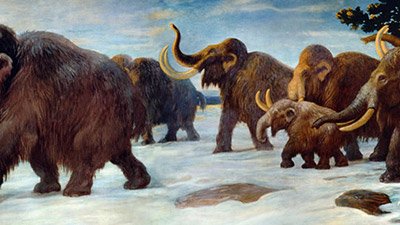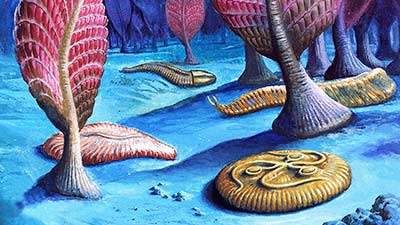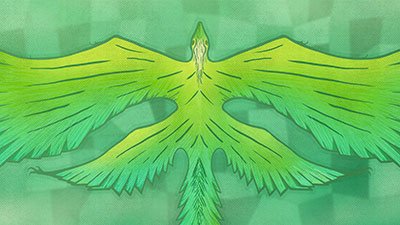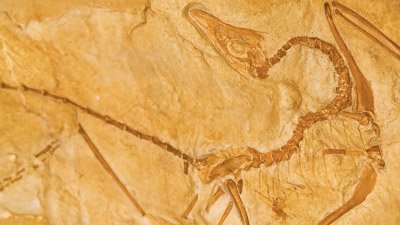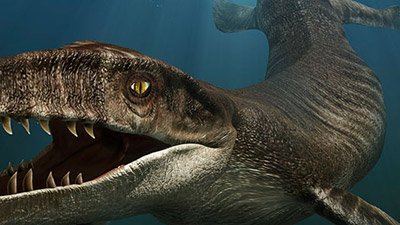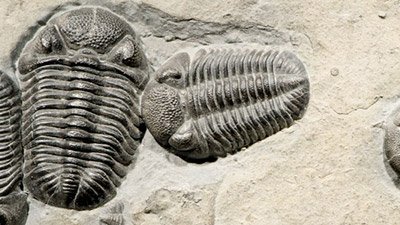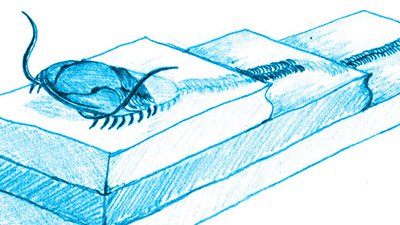Extinct Animals
Extinct Crocodile Kinds
The largest-known open-ocean crocodile was more than 20 feet (6 m) long and had a head the size of T. rex. Larger than modern saltwater crocodiles and even great white sharks, Plesiosuchus had flippers and a fish-like tail for swimming in the open ocean. We can only guess about the appearance of the teeth and jaws of the original created crocodile kinds.
So Many Mammoth Fossils
Varieties of fossilized mastodons, mammoths, and other elephants are widely distributed across North America and around the world. Fossilization in globe-encircling sediments laid down by water point to the catastrophe of Noah’s Flood. But—praise God—life’s deliverance from judgment encourages faith in the redeeming work of Jesus Christ!
Giant Fossil Bugs
The fossil record contains super-size versions of a number of creatures, including insects such as the giant dragonfly. Since no seagull-sized dragonflies fly the skies today, many wonder why they grew so large. The idea that gigantic varieties of creatures were stressed out of existence by climate changes in the wake of the global Flood is a biblically consistent explanation.
Extinct Animals Topics
-
Dinosaurs
God created dinosaurs on day six of creation, approximately 6,000 years ago. These fascinating creatures can now serve as “missionary lizards” for the gospel.
-
Ice Age Animals
The Ice Age was home to some giant and intimidating creatures, from mammoths to saber-tooth cats to giant sloths to massive cave bears.
News About Extinct Animals
-
March 17, 2022 from Ken Ham Blog
Scientists are working on trying to bring back a variety of extinct species, such as the woolly mammoth and Tasmanian tiger (thylacine). Will they be successful?
-
Feb. 10, 2022 from Ken Ham Blog
Unicorns—were they real? Most people immediately answer “no,” but not so fast.
-
Oct. 4, 2021 from Ken Ham Blog
Evidence suggest extinct crocodiles were herbivores, which aligns with the biblical perspective that animals were originally vegetarian.
-
Sept. 23, 2021 from Ken Ham Blog
The goal of a new start-up is to resurrect an ice-age era “woolly mammoth” by 2027. What does the Bible say about these created kinds?
Articles About Extinct Animals
-
March 21, 2017 from Answers in Depth
Saccorhytus is, the authors believe, the oldest and simplest known deuterostome, the evolutionary forebear of all vertebrates and some invertebrates.
-
July 31, 2016 from Answers Magazine
What is the first animal at the bottom of the fossil record? Most people think it’s in the Cambrian, among the trilobites. Not so.
-
Magazine Department ArticleI Must Go Down to the Seas AgainApril 1, 2015 from Answers Magazine
Cartorhynchus lenticarpus, whose discovery was hailed last November, is being hailed as an evolutionary link, but this characterization is premature.
-
Magazine Department ArticleGrounds for ReevaluationApril 1, 2015 from Answers Magazine
The fossil of a creature resembling a groundhog that lived during the time of dinosaurs has become an anomaly for evolutionists.
-
Feb. 6, 2015 from The New Answers Book 3
To think of the biblical unicorn as a fantasy animal is to demean God’s Word, which is true in every detail.
PDF Download -
Semi-Technical In-Depth ArticleHorse Ancestor Said to Have Evolved in IndiaJan. 29, 2015 from Answers in Depth
Like other extinct mammals that “suddenly” appear in the fossil record, this “discovery” is no mystery but a descendant of animals God created 6,000 years ago.
-
Magazine Department ArticleFeet of ImaginationOct. 1, 2014 from Answers Magazine
“Little Foot” is an australopithecine (southern ape), the most complete specimen yet discovered, and some say the oldest.
-
Magazine Department ArticleLook at the FishOct. 1, 2014 from Answers Magazine
Creationists point out that shared biological structures are the common designs we would expect from our common Designer.
-
July 24, 2014 from Answers in Depth
Up, up, and away—this large, long-feathered microraptorine was equipped for fast flight, steep descent, and a controlled landing.
-
July 22, 2014 from Answers in Depth
While there is nothing “transitional” about the feathers on Archaeopteryx, researchers claim new insight concerning the evolution of quill-like feathers.
-
April 1, 2014 from Answers Magazine
It’s an evolutionary icon, a supposed transitional form between two different kinds of animals. But the certainty about Archaeopteryx is now clouded by debate.
-
In-Depth ArticleWhale Skull Equipped for Sonar Shows Echolocation Appears Abruptly in the Fossil RecordMarch 22, 2014 from Answers in Depth
Moby Dick’s ancient cousin was well-equipped with sonar for hunting and mapping the bottom of the sea.
-
In-Depth ArticleDid Tiktaalik’s Pelvis Prepare Fish to Walk on Land?Feb. 21, 2014 from Answers in Depth
Previously shrouded in mystery, Tiktaalik’s pelvis supposedly sheds new light on the evolution of ambulatory hindquarters.
-
Did Archaeopteryx Evolve Flight and Then Get Grounded?Nov. 21, 2013 from News to Know
“Proto-bird” or transitional form? Archaeopteryx gets its walking papers at Los Angeles conference.
-
Is the Dawn of the Early Bird Too Good To Be True?June 10, 2013 from News to Know
Feathers are ruffled because the newest candidate for the first bird upsets the currently popular claim that Archaeopteryx was not a bird at all.
-
Research PaperMammoth Questions: Of Blood, Biological Antifreeze, and ClonesJune 8, 2013 from News to Know
New “fresh flesh and blood” mammoth discovery animates clonal hopes.
-
April 1, 2013 from Answers Magazine
The largest-known open-ocean crocodile was more than 20 feet (6 m) long and had a head the size of T. rex.
-
Cambrian Arthropod Had Legs on Its HeadMarch 23, 2013 from News to Know
Well-preserved Cambrian arthropod fossils prompt a response.
-
Toothed Bird Adds to Avian Biodiversity in Age of DinosaursJan. 26, 2013 from News to Know
A toothy robin-sized bird has been identified in the Early Cretaceous Chinese Jehol Group in northeastern China.
-
Ancient Flying Fish Around the GlobeNov. 10, 2012 from News to Know
Ancient flying fish flew in far-flung reaches of the globe.
-
Cambrian Invertebrate with Neural Complexity Similar to Modern InsectsOct. 20, 2012 from News to Know
Cambrian critter with neural complexity comparable to modern insects surprises evolutionary scientists.
-
Extinct Marine Crocodiles Resemble Killer WhalesOct. 13, 2012 from News to Know
Extinct marine crocodiles resemble killer whales.
-
Oct. 1, 2012 from Answers Magazine
What do physicists and paleontologists have in common? When discovering God’s complex design for trilobite eyes, expertise from both fields was required.
-
Mysterious Whale Fossils Found in DesertNov. 26, 2011 from News to Know
Which whale of a tale is true?
-
Ancient Whales and How Their Skulls Affected Directional HearingSept. 3, 2011 from News to Know
The whale evolutionary tale takes a new twist.
-
Giant Bugs: Why They Once Roamed the EarthAug. 20, 2011 from News to Know
Did giant insects seek or shun a high oxygen atmosphere?
-
Mosasaur: Lizard or Whale?Aug. 6, 2011 from News to Know
The mosasaur was a marine lizard, not a whale. But like the whale, evolutionists believe it started out—ancestrally speaking—without much in the way of swimming adaptations. Over 27 million years, researchers claim it evolved into such an excellent swimming predator that it ruled the seas.
-
The World’s Largest Marsupial Found In QueenslandJuly 9, 2011 from News to Know
A nearly complete skeleton of the world’s biggest marsupial, the Diprotodon, was unearthed at Floraville Station in Queensland. This specimen, 6-½ feet tall and 11 feet long, is estimated to have weighed three tons.
-
Semi-Technical In-Depth ArticleWill the Real Unicorn Please Stand Up?June 15, 2011 from Answers in Depth
The unicorns mentioned in the Bible are not the fairy tale creatures many people think of, but real creatures familiar to the people living in ancient times.
-
The Bunny KingMay 7, 2011 from News to Know
Once upon a time a rabbit king was buried on Minorca . . .
-
Fossil with Crocodile and Cat TraitsAug. 7, 2010
Cats and crocodiles may appear about as different as two vertebrates can possibly be. But a fossil found in Tanzania has traits of both.
-
Leviathan Found - According to Broad DefinitionJuly 3, 2010
Leviathan has at last been found—according to a broad definition of “Leviathan,” anyway.
-
Jan. 1, 2010 from Answers Magazine
Why do we find lots of trilobite tracks in lower rock layers, but we don’t find any trilobite fossils until higher up?
-
Fossil Seal Walks InApril 25, 2009 from News to Know
“Evolution at [w]ork,” declares National Geographic News. “[T]he evolutionary evidence we have been lacking for so long,” reports BBC News. So just what is this new fossil?
-
Fishy Old BrainsMarch 7, 2009 from News to Know
What’s so “remarkable” about the fossil preservation of a fish brain?
-
The Web of Spider EvolutionJan. 3, 2009 from News to Know
What was once “the world’s oldest spider” is now just a primitive version of the “web-spinning modern spider,” BBC News reports.
-
New Species Found In Insect Fossil On eBayAug. 23, 2008
Forget fieldwork. The trendy new way to discover fossils is as close as your Internet browser.
-
Ancient Shark Has a Bite Stronger Than a T. rexAug. 9, 2008
T. rex, stay out of the water: the ancient giant shark megalodon had a bite far more powerful than yours!
-
Magazine Department ArticleMonster RecordJuly 1, 2008 from Answers Magazine
The Monster, a partial fossil of what is presumed to be the largest known marine reptile has been found on a Norwegian island.
-
Fossilized Snake with Legs Found In LebanonApril 12, 2008
The strange monster is back: a snake with legs!
-
Giant Frog Fossil UnearthedFeb. 23, 2008
A team of American and British scientists has discovered a fossil frog so large it’s been dubbed “Beelzebufo,” or the “frog from hell.”
-
-
How to Catch an Extinct Fossil FishMay 26, 2007
Indonesian fisherman Yustinus Lahama’s capture of a rare coelacanth fish is a reminder of the perpetual fallibility of paleontologists (and much of what they say!).
-
Technical In-Depth ArticleTiktaalik and the Fishy Story of Walking Fish, Part 2May 23, 2007 from Answers in Depth
Now that the euphoria in the media has settled down on the “walking fish,” it is time to reflect upon what must surely be the biggest fish story of the decade.
PDF Download -
Semi-Technical In-Depth ArticleTiktaalik and the Fishy Story of Walking FishMarch 7, 2007 from Answers in Depth
Now that the euphoria in the media has settled down on Tiktaalik, it is time to reflect upon what must surely be the biggest fish story of the decade.
PDF Download -
Semi-Technical In-Depth ArticleDid Microraptor gui Invent the Biplane Before the Wright Brothers?Feb. 21, 2007 from Answers in Depth
Once again, the media is abuzz with feathered dinosaurs busily “experimenting” with flight. This time the presumed dinosaur, Microraptor gui.
PDF Download -
Swimming with the DinosaursMarch 8, 2006
One way or another, in the creation model, Castorocauda is another example of God’s fascinating design in a pre-Flood organism; in the evolution model, Castorocauda is a surprise and challenge.
-
Magazine ArticleTrilobite TechnologyDec. 1, 1998, pp. 23–24
Trilobites, described by Stephen Jay Gould as ‘everyone’s favourite invertebrate fossil,’ are a class of marine arthropods which are often well preserved and of striking appearance.
Recommended Resources

Answers in Genesis is an apologetics ministry, dedicated to helping Christians defend their faith and proclaim the good news of Jesus Christ.
- Customer Service 800.778.3390
- Available Monday–Friday | 9 AM–5 PM ET
- © 2025 Answers in Genesis



